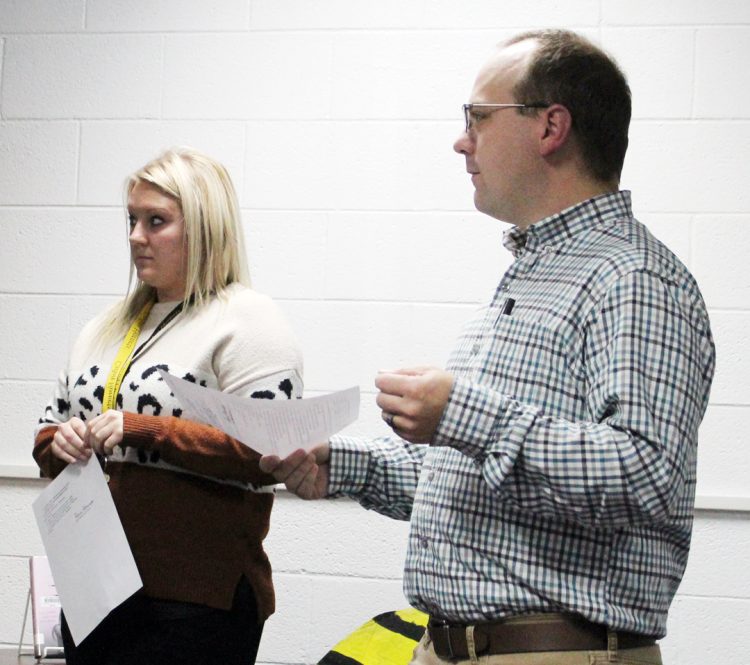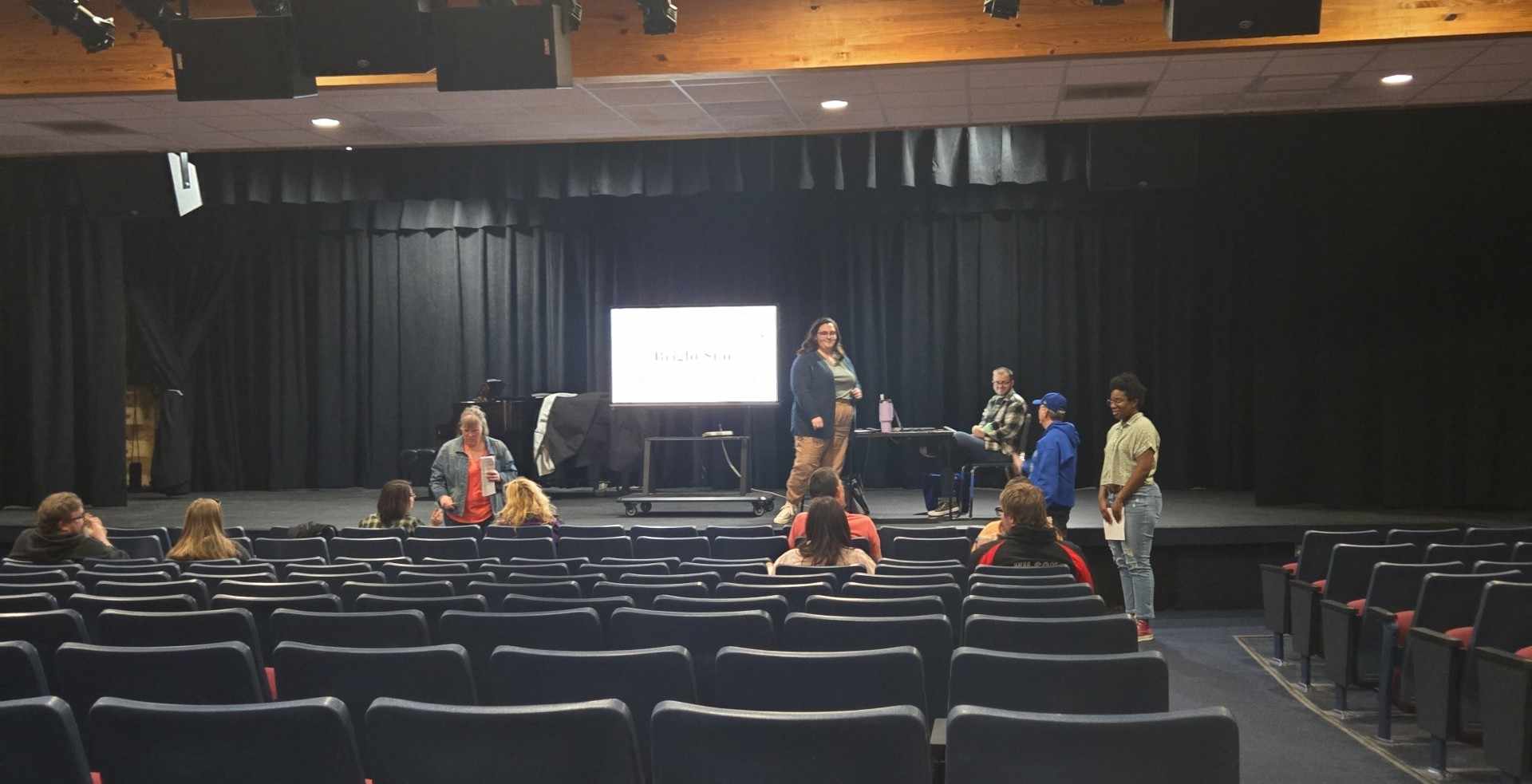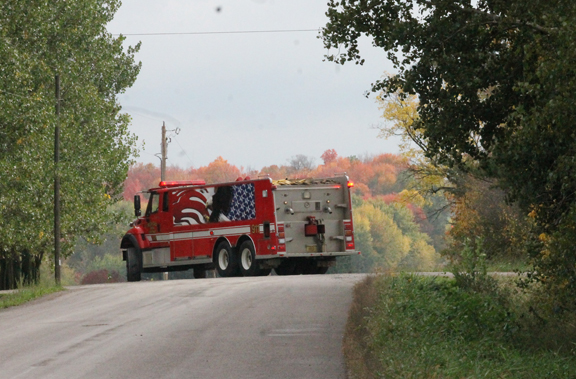Cadott School Board; Logging completed as part of forest management plan


Keith Becker, teacher (front), updated the Cadott School Board on the activities done as part of academic and career planning, during a regular meeting Nov. 8. He touched on the requirements around the work study and youth apprenticeship programs, as well as the participation numbers for each. Photo by Julia Wolf
By Julia Wolf
The Cadott School forest looks a little different, after work toward the forest management plan was recently completed. School board members heard an update on how the project went, during a regular meeting, Nov. 8.
“We kind of went through our first round with the logging of the school forest,” said Jenny Starck, superintendent.
Mike Dahlby, Dahlby Conservation Services, was on hand to talk about the process, as well as what they got for product.
The district entered into a service agreement in February, where Dahlby managed the implementation of the DNR’s plan for the property.
“We just worked through it systematically,” said Dahlby. They began by marking the timber, to decide what should come out to achieve the forest management objectives.
“We were making decisions based on what’s best for the forest,” said Dahlby.
From there, they estimated the worth of what the timber removed would be. Dahlby says they received two bids for the work and Kron Forest Products, Holcombe, was chosen to do the work.
Dahlby says the contract with the logger was set up on a per-unit basis, for actual yield, but the yield was a little short of what was estimated it would be.
“A lot of the timber was actually overmature,” said Dahlby, explaining they found more rot in the timber than they anticipated before cutting.
He says the jack pine stand on the north side was an area with the biggest discrepancy from what was expected.
Starck reminded board members that the district had a late start on the implementation of their forest management plan. Board member Ced Boettcher asked what the next step will be in the forest management plan.
Dahlby says everything was done with an eye toward natural regeneration, so no planting is needed. He says there is some higher ground with hardwoods that could use selective thinning in the future, as well as some thinning of ash trees near the river.
“You really probably don’t want to disturb everything,” said Dahlby. “You like to get a couple years in between there.”
Cory LaNou, board member, asked where the money from the timber goes. Starck says it goes into the school forest fund, for any needed improvements.
“The heating system needs to be replaced out there,” said Sue Shakal, director of finance.
Board members also heard an update on how academic and career planning is going, from teacher Keith Becker. Becker says students have two main options for work-based learning, the work study program and youth apprenticeships, and went over the numbers and career paths for each.
“When I call the employers, I always ask growth questions,” said Becker, such as the students strengths and weaknesses, and ways they can grow professionally.
Becker also gave an overview of other elements of academic and career planning, like junior and senior nights, staff training, a grade eight technical college tour, job shadows, and grade nine technical college and university tours. Industry tours are also planned for the spring.
The board also got to see a first look at the state test results, by grade, as well as breakouts of the scores with students with disabilities or economic disadvantage.
Starck explained that the state test results are different than the DPI report card, though the state test data does factor into the report card.
Baseline data for Social Emotional Learning was also presented, during the meeting. Starck explained that students in the elementary and secondary levels are screened to determine if they have strengths, needs or are typical.
“What happens with students who have needs, is then, they are put into small groups who work with counselors, who work with other support staff,” said Starck.
In the business portion of the meeting, the board approved making the YANA (You Are Not alone) Club a district-recognized club.
“It’s kind of like a friendship club,” said Starck, adding that the goal is that everyone should have friends and someone to eat lunch with, with students in the club encouraged to reach out to others.
Starck says the YANA Club meets during the school day, and would also like to start community impact projects, such as raising money for causes.
Starck also brought up the Gay/Straight Alliance group, as an informational item. She says non-affiliated clubs, like the Gay/Straight Alliance, which meet outside of school hours, would not usually come before the board.
“Because it’s a sensitive topic, I wanted to make sure we have some transparency with it,” said Starck.
She says the group falls more under the category of facility use and is part of equal access.
Members did approve an additional assistant archery coach position. Starck says the position is for additional one-on- one work with students and safety, as more students are participating in archery.
Also approved, was the hire of Luke Rykal, junior high boys basketball coach; Brent Crank, junior high boys basketball coach; Benjamin Elbert, C-Team boys basketball coach; Corey Smith, gaming/eSports coach; and Kaden Christenson, archery assistant.
Board members also shared feedback they heard on the livestream of the board meetings.
LaNou says he has heard that some of the board members can be difficult to hear on the livestream. Starck says a longer microphone cord or lapel microphones are options that were discussed before. LaNou suggested looking into closed captions may also be a good option.
Members also discussed how to decide which student activities should be livestreamed and how to make that work. Starck says she has talked to Nick Kotek, school librarian, about options. One option would be for Kotek to set up everything, so a parent or student can be responsible for livestreams during the event.
“Some, logistically, are going to be trickier than others,” said Starck, noting baseball and softball might be difficult to follow, even if someone in the stands livestreams the game.
LaNou suggested even a few tablets with a tripod to check out would work for events that are in places other than the big gym.
“Most phones and tablets today, are actually better than even that is,” said LaNou, referencing the current camera.
Others thought it sounded like a good idea and Starck says it is a possibility they can look into.



